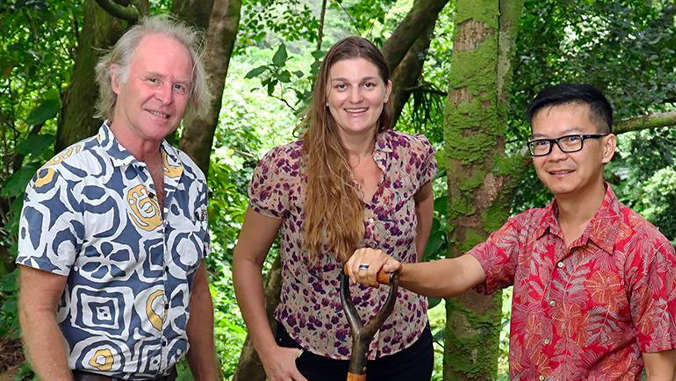
To study the effect of fungal-bacterial interactions on nutrients such as carbon and nitrogen in soil, a three-year $3.4 million grant was awarded by the U.S. Department of Energy to an interdisciplinary team headed by University of Hawaiʻi at Mānoa Department of Tropical Plant and Soil Sciences Associate Professor Nhu Nguyen.
A single teaspoon of soil contains billions of bacteria from thousands of bacterial species, interacting with kilometers of fungal hyphae (hyphae are the long filamentous branches that make up the body of a fungus), which release digestive enzymes in order to absorb nutrients from food sources. These microorganisms are the machinery that drive important elemental cycles such as carbon and nitrogen on the planet. Researchers don’t quite know how these microbial interactions behave across different soils.
Hawaiʻi’s vast diversity of soils accounts for more than 80% of soil types on the planet, making it the perfect environment to study these dominant members of the soil microbiome.
“Because of our island topology and small landmass, we can control for environmental factors, including climate and host plants, that can influence the soil microbiome,” said Nguyen. “The diversity of soils in Hawaiʻi plays a central role. In other words, this work can only be done in Hawaiʻi, and because each of our soils is representative of those found in larger continental landmasses, our findings would be translatable to other soils across the world.”
Nguyen and UH Mānoa soil scientists Jonathan Deenik and Tai Maaz have partnered with Maggie Yuan of University of California, Berkeley, Jizhong Zhou of University of Oklahoma and Jennifer Pett-Ridge of the Lawrence Livermore National Laboratory. The team is hoping to find out if fungal-bacterial interactions can change whether carbon and nitrogen molecules are kept sequestered underground or if they are released into the atmosphere, contributing to climate change.
“The soil holds more carbon than all aboveground biomass and atmosphere combined, and soil microbes cycle the available nitrogen that sustains much of terrestrial life,” said Nguyen. “Whether these molecules are contributing to climate change is likely connected to the interactions among the millions of species of fungi and bacteria that live there.”
“I am very excited to be working with a fantastic team to figure out how interactions among members of the soil microbiome can determine the fate of molecules that warm the planet,” Nguyen added. “As these molecules flow through microbes in the soil, they can be captured by plants and thus help provide pathways toward sustainable agriculture—a system that both provides food and keeps carbon and harmful nitrogen molecules from leaving the soil.”
The science behind it
Nguyen explained that due to the extremely complex nature of soil, the researchers will leverage tools they developed over the last decade, using stable-isotopes to trace carbon and nitrogen molecules as they move from atmosphere, into plants, into microbial cells, and eventually onto soil mineral surfaces, where they can be stabilized or released back into the atmosphere.
The strength of the project lies in combining stable isotopes with multi-omics tools (metagenomics—the study of genetic material recovered directly from environmental samples, metatranscriptomics—the science that studies gene expression of microbes within natural environments, and metabolomics—the large-scale study of small molecules) and pulling all of these data streams together into a microbially informed ecosystem model.
This systems biology approach, scaling from molecule to organism to ecosystem, is fundamental to understanding the complexity of processes that happen within the soils and translating them to meaningful outcomes, such as mitigating climate change and supporting sustainable agriculture.
This work will contribute to an ongoing initiative at UH to study the microbiome of natural and human-associated environments.

